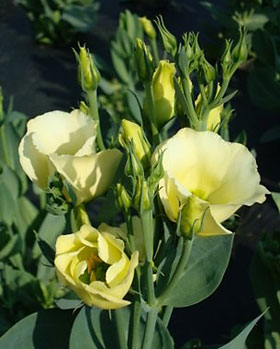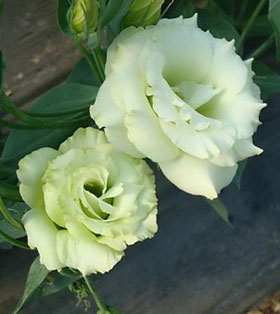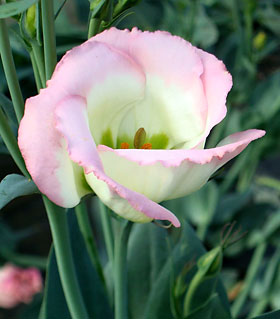
Eustoma grandiflorum
Propagation:
- Lisianthus has tiny seeds, and is very slow to reach transplant stage. Sowing in late January in a greenhouse will result in transplantable seedlings in early May.
- Growers that direct-seed should insist on pelleted seed, to make the seed visible to the eye.
- Seed should be sown on the surface and not be buried.
- Cell trays with 144 to 228 cells have given good germination and seedling size.
- To avoid long greenhouse seedling period, consider buying seedlings from commercial sources.
- After germination at 70 to 75 F, grow on at 50 to 65 F to prevent rosetting, the inhibition of stem elongation brought about by warmer temperatures.
- Rosetting is prevalent in some varieties at temperatures above 72 F during the seedling growth stage, until the fifth leaf pair has formed.

Growing:
- In the protected environment of the high tunnel, lisianthus seedlings grown in small seedling cells can make good growth after transplanting.
- Avoid delayed transplanting and crowding in the seedling tray which could permanently stunt the plants.
- Allow 60 to 75 days from transplanting to flowering.
- Spacing in the plant bed of 6 x 6 in. is common; at 9 x 9 in., plants produce more branches, but give lower overall yield.
- Use horizontal 6-inch-square netting to help keep plants upright.
- Pinching the plant apex to leave 6 lower leaves has not increased yields in our trials, and delayed flowering by about 10 days

Varieties:
- Lisianthus varieties are either single- or double-flowered, with a range of flower colors in each type, ranging from white, cream, green, pink, blue and purple.
- Darker edging of petals (picotee) and darker flower centers add interesting color variations to some varieties.
- Earliest varieties will begin flowering in late June from a February sowing (eg. Echo series, Group 1). Late varieties can be a month later, but will have longer stems (Group 3). Varieties in Groups 1 and 2 have shown good adaptation to high tunnel production in New York State.
- Ruffling of petal edges makes flowers appear fuller even with fewer petals.
- Spray types with small single flowers (Fioretti) provide additional variation in lisianthus types.
Postharvest Handling:
- Lisianthus has outstanding vase life, commonly up to 14 days or more.
- Commercial vase life solutions stimulate bud development and aid vase life.
For more information, see: Armitage, A.M. and J.M. Laushman. 2003. Specialty Cut Flowers, 2nd Edition. Timber Press, 586 pp. Available through ASCFG.


